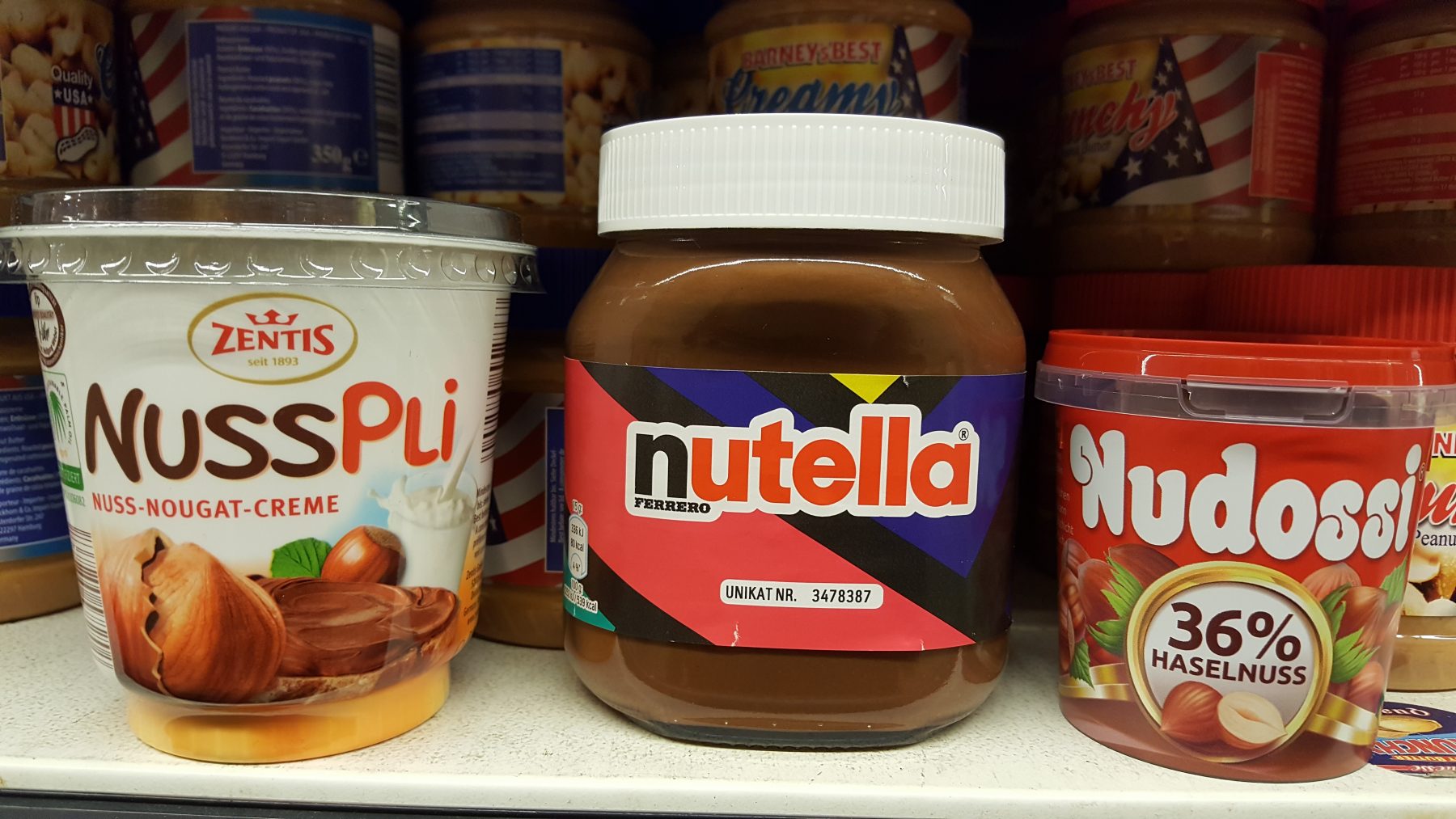Thanks to the necessity of store-brand knock-offs, there are infinite numbers of chocolatey hazelnut spreads in Germany (and beyond) these days. Some are more hazelnutty, others are more chocolatey and some are just a cloying goo that begs the question of why they were ever produced (usually served at downmarket hotels and corporate breakfast buffets). But for me, only three hazelnut spreads have made it into the canon of hazelnut spreads – Nutella, Nudossi and Nusspli. The complexities of familial politics mean that only Nutella ever lands on our table but, thanks to this blogpost, we will now, for a time, also have the other two. And by “complexities” I mean “my children’s preference”. Though it rarely shows up on list of things that are über-German, Nutella is as much a part of the German experience as airing out a room, Oktoberfest and white asparagus. If there’s no hazelnut spread on the breakfast table, then you can be sure it’s not an authentic German breakfast.
Hazelnut spreads – Nutella
Nutella is the undisputed king, nay, emperor of hazelnut spreads, if only because Nutella invented Nutella, which later became known as hazelnut spreads. In post-war Europe, chocolate was hard to come by so Pietro Ferrerro threw in a little hazelnut and first created a hazelnutty loaf that his son would refine into Nutella in the ‘60s. Or at least that’s the way Nutella tells it. I first encountered Nutella on my first-ever morning in Germany and, after my first taste, wondered why anyone would ever live anywhere else. For years I thought the Germans had invented Nutella, and I acted as a Nutella evangelical. It was in my role as Nutella evangelic that I discovered a funny phenomenon – every North America Nutella lover I met thought it was invented in whatever country they first encountered it. People claimed it was invented by the French, the Danish and even the Czechs. At the time, I argued that it was invented by the Germans. Everyone was wrong!
We all now know it’s from Italy, like so many good things. Sometimes I think that country has so much goodness that they have to occasionally elect odd governments just to even out their reputation. Good on indulgence, bad in politics, or something.
Hazelnut spreads – Nudossi
For a brief period I once dated a woman who grew up in East Germany and she introduced me to Nudossi. “It’s the East German Nutella!” she said. She loved it as a kid and no other hazelnut spreads were allowed on her breakfast table. I didn’t argue, though I found it a bit oily. I’ve bought it occasionally since and didn’t think much about it. But it turns out Nudossi has an interesting post-Berlin Wall history that serves as a warning to be careful what you joke about – a lesson I wish I’d learned earlier. I once worked for a fast-growing publisher in Denver and joked during a staff meeting that we’d soon have enough people to field a softball team. Two weeks later I was on the pitching mound. My brother also once joked at a Christmas party that if his Boulder, Colorado software company wanted to expand to Europe, he was their man. He now lives in Amsterdam.
Anyway, a guy named Karl-Heinz Hartmann bought a factory in Radebeul, near Dresden, to produce Stollen (a marzipany Christmas cake) and during a press conference about his plans, a reporter asked him if the factory wasn’t the place where Nudossi had been produced. “Of course,” he said. “And it’ll be back.” He was just joking, according to Die Zeit. But he made good on the joke (like me on the softball diamond and my brother and his wooden clogs). The company has had some hiccups but is now successful – Nudossi supposedly has twice as much hazelnut as Nutella and the company even makes a non-palm-oil version.
Nudossi was first produced in 1970, if Wikipedia can be believed, again because of the lack of cacao in East Germany. Production ended temporarily in 1994 when Vadossi, its manufacturer, went bankrupt. The rights to the name were originally picked up by regional broadcaster MDR, but Hartmann was able to get them back after he made that prophetic joke.
Hazelnut spreads – Nusspli
When I was an exchange student, my host family swore by Nusspli. You would think they’d never heard of Nutella (and lord knows if back then, when the Wall was still up, if you could even get Nudossi in the West). To me, it tastes more hazelnutty. At the time, I thought this was why Nusspli was the hazelnut-spread-of-choice in their home but in researching this article I think it might be regional – Zentis, which makes the stuff, is based in Aachen and we were just a short car trip from the place. Like Nudossi, Nusspli didn’t appear until the 70s, along with Kraftwerk and the VW Golf (which was called the Rabbit in the US).
Great, now I’m hungry.
4 Comments
